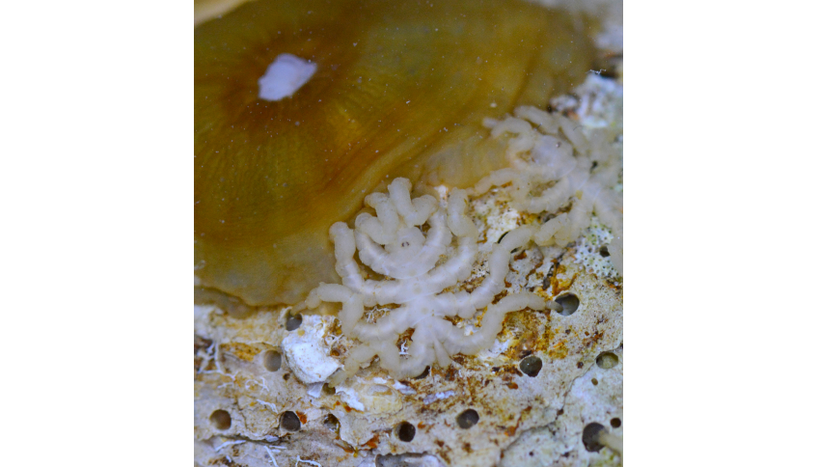
Fig. 1: Pycnogonum litorale, adult male feeding on a sea anemone. C: Georg Brenneis
The first high-quality pycnogonid genome provides novel insights in chelicerate evo-devo
An international collaboration featuring the University of Vienna and the University of Wisconsin-Madison (USA) has led to the first-ever chromosome-level genome assembly of a sea spider (Pycnogonum litorale). The genome informs about the development of the characteristic sea spider body plan and constitutes a landmark for revealing the evolutionary history of chelicerates in general. The study was recently published in BMC Biology.
Sea spiders (Pycnogonida) are marine arthropods with highly unusual anatomy: their trunk is very narrow and short, many of their internal organ systems extend into their long legs, and their abdomen is extremely reduced, to the point of being almost unrecognisable. Together with much better known animals such as spiders, scorpions, mites, or horseshoe crabs, sea spiders belong to the group called chelicerates, named after their claw-like mouthparts, the chelicerae. The bizarre body plan of these "no-bodies" raises fascinating questions: what genetic factors underlie its formation? And what can this tell us about the evolutionary history of chelicerates? The answers lie in their genome.
A high-resolution genome
To produce the genome assembly, researchers combined complementary sequencing technologies. First, the genetic material of a single P. litorale individual was obtained using so-called "long-read sequencing", a technology that is able to capture very long stretches of DNA. This facilitates the correct assembly of otherwise challenging repeated or complex genomic regions. Then, the spatial organisation of the genome was assayed in a second P. litorale individual, revealing which DNA pieces lie close to each other in the cell nucleus. By leveraging the distance information, the correct order of the sequenced DNA stretches can be ascertained. This combination of data sources led to the assembly of 57 pseudochromosomes, representing almost the entirety of the sea spider genome in unprecedented resolution. This was additionally supplemented by novel datasets of gene activity in various developmental stages of P. litorale. "The genomes of many non-canonical laboratory organisms are challenging to assemble, and Pycnogonum is no exception. Only the combination of modern high-throughput data sources made a high-quality genome possible", says the study's first author Nikolaos Papadopoulos from the Department of Evolutionary Biology at the University of Vienna. "This can now serve as a stepping stone for further research."
Lost genes, visible effects
The research team paid special attention to the so-called Hox cluster - a gene family that is evolutionarily conserved across the animal kingdom. "In arthropods, Hox genes play a central role in the correct specification of the different body segments; but also in many other animal groups they are essential 'master controllers' during body plan development", explains Andreas Wanninger, one of the project leads at the Department for Evolutionary Biology at the University of Vienna. The exciting secret of Pycnogonum litorale: a part of the Hox cluster is missing completely from the genome, namely abdominal-A (Abd-A), a gene typically involved in specification and development of the posterior part of the body. Its absence could be linked to the extreme reduction of the pycnogonid abdomen. Similar conditions have been observed in other arthropods with reduced posteriors, such as certain mites and barnacles. Thus, sea spiders offer another example for the well-documented evolutionary relationship between Hox gene loss and body part reduction.
The genome also offers insights into broader evolutionary patterns. Unlike spiders and scorpions, whose genomes show clear signs of ancient whole-genome duplications, no such traces can be found in the genome of P. litorale. As pycnogonids are considered the sister taxon to all chelicerates, this suggests that the genome of the chelicerate ancestor did not already have these duplications; rather, they must have happened much later in evolution, for certain chelicerate sub-groups.
A new reference genome
This newly assembled high-quality genome paves the way for further comparative studies. P. litorale thus becomes a novel valuable reference species in regards to questions about the interrelationships between chelicerates and the evolution of their body plans, as well as the genetic mechanisms that underlie the diversity of arthropods. "From an evolutionary developmental perspective, sea spiders are very interesting: their mode of development may be ancestral for arthropods, but at the same time they boast multiple body plan innovations unique to themselves. Beyond this, they also possess remarkable regenerative abilities", explains last author Georg Brenneis of the Department of Evolutionary Biology at the University of Vienna. He adds: "Now that we have the genome and comprehensive datasets on gene activities during development, we can systematically study all of these aspects on the molecular level."
The researchers will use the novel reference genome for further studies on gene regulation, development, and regeneration in chelicerates, aiming to better understand the processes underlying the evolutionary success of this group.
Original publication:
Nikolaos Papadopoulos ;Siddharth S. Kulkarni; Christian Baranyi; Bastian Fromm; Emily V.W., Setton; Prashant P. Sharma; Andreas Wanninger; and Georg Brenneis. The genome of a sea spider corroborates a shared Hox cluster motif in arthropods with a reduced posterior tagma. In BMC Biology (2025).
Fig. 1: Pycnogonum litorale, adult male feeding on a sea anemone. C: Georg Brenneis
Fig. 2: Pycnogonum litorale, adult female feeding on a sea anemone. C: Georg Brenneis






